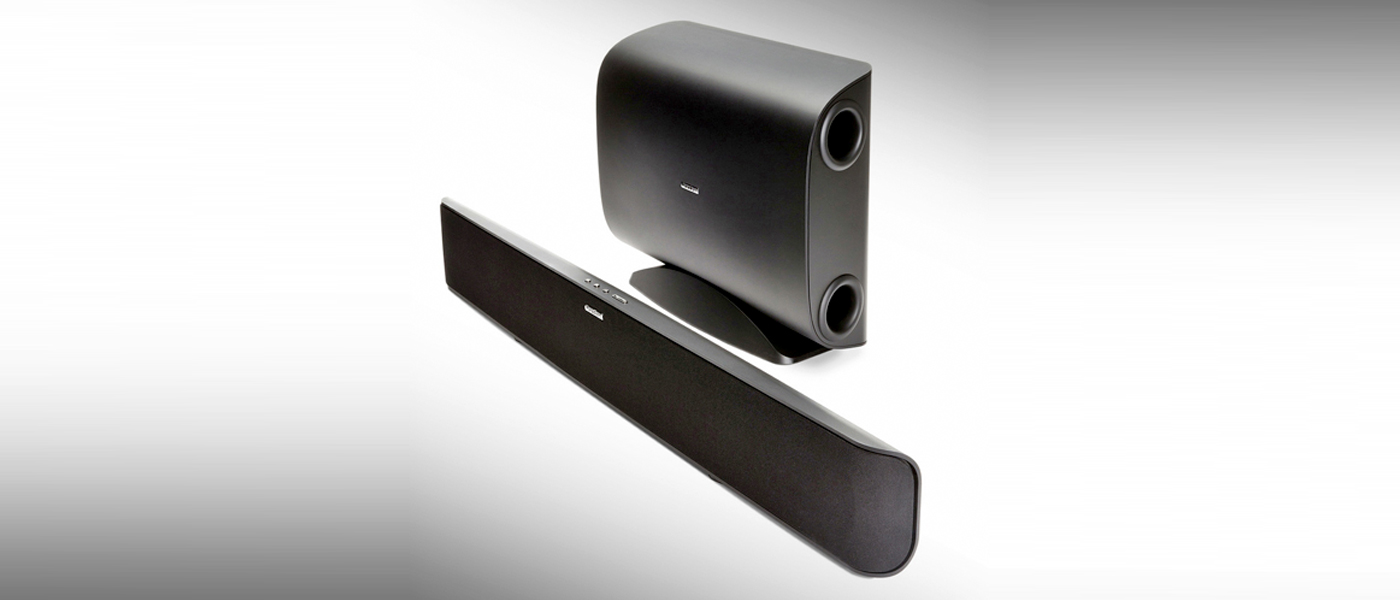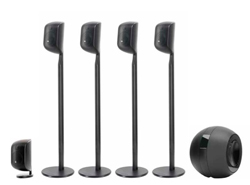
Introduction to the Bowers & Wilkins MT-60D Speaker System
I think it’s best in reviewing a sub/sat speaker system to get the obvious of out of the way. These systems will not rival large boxes for scale, dynamic range, or efficiency no matter how much power you feed them, how high a cross over you use or how many or how big a sub is paired with the system. The job of a sub/sat system isn’t to fill a large space with sound. In the same way that a small speaker with a powerful sub could never fill a large home cinema with the proper scale. A large speaker would absolutely overwhelm and destroy the acoustic space of a small room. Sub/sat systems are best when used in an environment for which they are properly sized. Sub/sat systems also poses some wonderful qualities large speakers struggle to provide. Imaging and perceived speed. Placed in the right room a subwoofer and satellite system has the capability to deliver world class sound.
With that rant out of the way, the Bowers &nd Wilkins MT-60D system represents more than a typical sub and satellite speaker combo. There are many good sounding system available. What really sets the combination of the M-1 speaker and PV1D subwoofer is design. B&W has always been one of those audio companies at the leading edge of style and design. An attribute even more important with a lifestyle sub/sat system.
The MT-60D promises achingly good looks with exceptional audio performance.
BOWERS & WILKINS MT-60D SPEAKER SYSTEM SPECIFICATIONS
M-1 Satellite Speaker
- Design: Modular, Two-way
- Drivers: One 1″ Aluminum Dome Tweeter, One 4″ Woven Glass Fiber Woofer
- MFR: 55 Hz – 50 kHz
- Crossover Frequency: 4 kHz
- Nominal Impedance: 8 Ohms
- Sensitivity: 85 dB/2.83 Volts/1 Meter
- Maximum Power Handling: 100 Watts
- Dimensions: 9.8″ H x 4.5″ W x 6.4″ D
- Weight: 5 Pounds/each
- MSRP: $249.99/each – Matte Black, Matte White
PV1D Subwoofer
- Design: Sealed Enclosure
- Drivers: Two 8″ Paper/Kevlar/Aluminum
- Amplifier: 400 Watts
- MFR: 35 Hz – 250 Hz, – 6 dB
- Inputs: Stereo Line In (RCA), Speaker Level In, RS-232, Trigger On/Standby, Trigger Preset Switching
- Dimensions: 13.5″ H x 10.6″ W x 14.1″ D
- Weight: 41 Pounds
- MSRP: $1,700 USD – Matte Black, Matte White
- Bowers & Wilkins
- SECRETS Tags: Bowers & Wilkins, Speakers, 5.1, Home Theater Speakers
Design of the Bowers & Wilkins MT-60D Speaker System
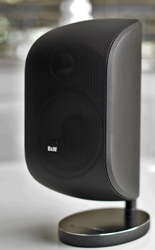
There are few speakers at any price that are as beautifully executed from a design perspective as the M-1. At first glance the differences between the new M-1 and the previous generation are hard to spot. It takes time to appreciate to subtlety and refinement to the M-1 design. The overall shape and character are similar for sure.
Details, details, details. Contours are better defined. Edges have a more refined bevels, the detailing is toned down and more elegant, especially the pedestal/base.
Materials including soft touch plastics and rubber lend to a better tactile experience when handling the speakers. All small design tweaks that add up to a product exuding more luxury and refinement than the previous generation M-1.
As part of the updates the M-1 receives improvements to the tweeter, woofer, cross over and connectors. The spring loaded gold plated connectors for attaching speaker cables are much improved over the old set screw design.
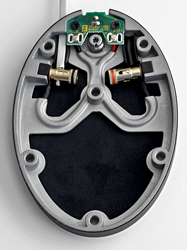
The new connectors and revised routing also allow for thicker speaker cables to be used. Drivers have been refined across the board. The tweeter utilizes a Nautilus tapered and damped tube to cancel out the back wave energy of the tweeter for less distortion. Additional improvements have been made to the bass driver to lower the bass response from the previous 90hz down to 50hz. To achieve this some trickle down technology from the PM1 in the form of an Anti Resonance Plug. Additionally a four layer voice coil has been added for a claimed increase in efficiency and power handling. The M-1 also receives a simpler but higher quality 1st order cross over much like the rest of the Bowers and Wilkins product line.
While the M-1 receives tweaks and updates the PV1D feels more like an outright new product. It looks like the previous PV1 but it seems to only share good looks. The PV1D is a computer with a few drivers installed in what B&W refers to as a pressure vessel. The D most assuredly stands for digital and I doubt that reference is for the 400 watt amplifier powering the twin 8″ drivers (this is not a passive radiator with an active driver set up). Digital Signal Processing is used extensively in the PV1D to improve performance across the board. The DSP is used to insure lower distortion and greater extension, tailor the cross over and built in EQ for specific B&W speakers and if hooked up to a Windows PC (I only have a Mac) the DSP can be used to do custom tailored EQ settings. Changes can also be made through the front panel display.
Setup of the Bowers & Wilkins MT-60D Speaker System
The M-1 speakers can be used as they come with the attached pivoting stand/mount.
Mounted directly to the walls with the supplied mount (including a sleek cable pass through) or with the optional and reviewed stands. There’s not a lot of set up if using the factory attached stand. Simply remove the rubber pad underneath the base.
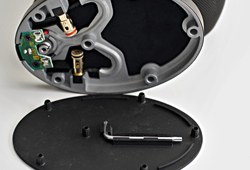
While the optional floor stands look stunning and provide an ideal solution for free standing applications, the over ease of setup of the stands is not up to par with the M-1 speakers. Speaker wires have to be run through the column of the stand, there’s a plastic set screw to limit the movement of the attached speaker which is entirely too fragile and easy to damage, the speaker does not positively engage into the stand either. There’s difficulty in getting the stands set up but once completed you thankfully never have to touch them again.
The PV1D in contrast is as simple as plugging in the supplied power cord, one RCA connection from my Marantz AV-7005. Using the OLED display and D-pad I set the PV1D to a line input, the default input sensitivity, gain, polarity and defeated the internal crossover. There are options for selecting specific B&W speakers including the current and older M-1. Doing so will tailor the slope and frequency of the cross over to best match the chosen speaker. Additionally if you’re running Windows you can access the PV1D SubApp program to do more detailed adjustment of the settings. I only run Mac OSX so I was unable to test the software.
One very nice thing about the manual for the PV1D is the specification for DSP processing delay. If you’re not using an auto setup system that can accurately measure subwoofer distance or in a 2.1 set up with no time delay, it can be extremely difficult to properly integrate a subwoofer. Not knowing how much processing delay is built into the sub assures an inaccurate placement of the sub if you’re trying to time align the sub and your main speakers. You have to add the time (as a function of distance) into your distance measurements. Bower and Wilkins specifies a time delay of 1 foot. You have to add 1 foot to your actual measurement. This is under a millisecond of processing delay.
With speakers of such a small size it’s not typically detrimental to have them close to walls or corners. In fact I noticed minimal bass loading effects during adjustments of placement in my room. With no sub reinforcement it was best to keep the speakers no more than 2 feet from the back wall or I would get a slightly lean sound. With the sub in place I was more focused on achieving the best imaging. Final installation consisted of five identical M-1satellites. For on the supplied stands at the Front L&R and Rear L&R locations, with the fifth as a center channel stood vertically (the speaker can be rotated 90 degrees) on top of an equipment rack below my TV. The PV1D was placed slight off center from the front wall. All listening was done with the Marantz AV-7005 pre-amp running to a Myryad MA500 multi channel amp with 100 watts per channel. All listening was performed after a full Audyssey XT calibration.
The Bowers & Wilkins MT-60D Speaker System In Use
Two aspects of the M-1 speakers stand out upon listening to them. One, like most good small speakers the imaging is tremendously accurate with razor thin placement of sounds across the sound stage. Two, the level of detail and resolution is impressive given their price. As with most modern Bowers and Wilkins speakers the M-1s are titled upwards in the treble region. A bit forward and bright which in most affordable speakers would mean harshness. In the M-1 the tweeter is so free of distortion and harshness that the effect of that brightness is to reveal extra levels of detail. This works especially well for movies and for well recorded music. With more modern music the speakers are never fatiguing but I could see if partnered with a cooler or brighter amp the combo could border on tiresome.
In practice with a well partnered amp and with identical speakers at all five locations the imaging and detail in the best movie mixes is enthralling and exciting. The sound draws you in with lighting fast panning with no discernible tonal shifts as sounds pan across the speakers. Especially spanning the front three speakers. Once you’ve listened to a 5.1 or 7.1 set up with identical front speakers you’ll find it difficult to revert back to using a different speaker for the center channel. The MT-1 Can be rotated 90 degrees for center channel use.

The PV1D provides a visceral foundation to the M-1 quintet. It’s authoritative, clean, and dynamic. Running of the Marantz AV-7005 and using Audyssey XT the integration between sub and satellites is superb. Crossed over at 80hz there’s no discernible hole in the lower mid bass. Listening to music through the AV-7005 the 2.1 combo of M-1 and PVID provide an exciting and fun listen with just a smattering of refinement. For the price and intended application I’ll take this approach. In a smaller space these qualities will yield a more enjoyable and emotional connection with most music. A flatter and more refined approach would yield too small a window into the energy of most recordings. It may no suit most classical or jazz lovers but for most other music it does well. It will never project rock or hip hop into your room with tenacity but it will convince you there’s real energy and power.
Conclusions about the Bowers & Wilkins MT-60D Speaker System
The MT-60D is not an inexpensive 5.1 system. It’s good to know that the level of investment you make brings you exceptional design in addition to class leading sound.
In a world of homogenous speakers the M-1 and PV1D combo stand out as sultry and sophisticated designs. The perceived value is higher than the price suggests and would look fantastic in most smaller spaces. Given the high level of sonic refinement Bowers and Wilkins has produced a speaker package that is difficult not to praise. Properly partnered and scaled to the right room size, this is a fantastic way to enjoy music and movies for years to come.


